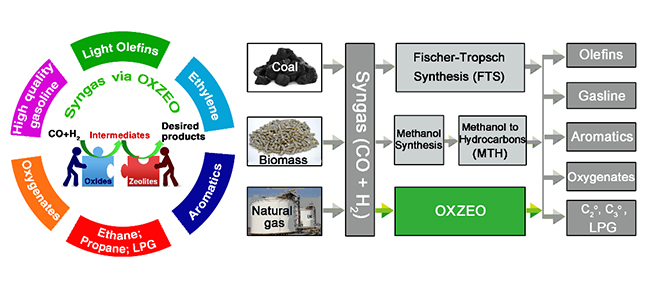Oxide-zeolite-based Composite Catalyst Concept Enables Syngas Chemistry beyond Fischer-Tropsch Synthesis
Fischer-Tropsch synthesis (FTS) has been applied as the core technology of coal-to-liquid and gas-to-liquid processes in industry. However, the product selectivity control of syngas conversion still remains challenging.
A group led by Prof. PAN Xiulian and Prof. BAO Xinhe from the Dalian Institute of Chemical Physics of the Chinese Academy of Sciences (CAS) proposed the oxide-zeolite-based composite (OXZEO) catalysis concept, which can separate activation of reactants CO and H2, and C-C coupling onto two different types of active sites.
Recently, the researchers summarized the state-of-the-art, opportunities and challenges of the OXZEO catalysis concept in the field of C1 chemistry. The study was published in Chemical Reviews on May 25.

Oxide–zeolite-based composite catalyst concept that enables syngas chemistry beyond Fischer–Tropsch synthesis (Image by JIAO Feng and MIAO Dengyun)
The concept turned syngas conversion into a tandem reaction and allowed the product selectivity to be manipulated by shape-selective zeolites. It enabled direct conversion of syngas to a variety of chemicals and fuels with their selectivity surpassing the limit predicted by Anderson-Schultz-Flory model via the conventional FTS route.
A rapidly increasing number of studies showed that OXZEO formed a new technology platform for efficient utilization of carbon resources such as coal, natural gas and biomass via syngas in addition to FTS and methanol technologies, as well as utilization of CO2 as a carbon resource via hydrogenation to a variety of chemicals
However, the selectivity control mechanism is far from being understood. Therefore, further studies should focus on the selectivity control mechanism of the OXZEO concept in order to understand the challenges and prospects for future development of much more active and more selective catalysts.
This work was supported by CAS, the Ministry of Science and Technology of China, and National Natural Science Foundation of China. (Text by JIAO Feng and MIAO Dengyun)